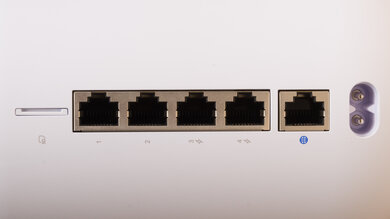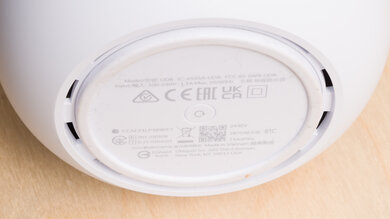The UniFi Dream Router is a dual-band Wi-Fi 6 router and the successor to the Wi-Fi 5 UniFi Dream Machine. It's manufactured by Ubiquiti, a company that primarily offers networking products geared towards small business and enterprise users. As such, this router offers a suite of features that are well-suited for users with more advanced networking needs, like PoE (Power over Ethernet) networking ports and 128GB of built-in storage for video surveillance footage. In addition to UniFi's 'Network' application, it supports the 'Protect,' 'Talk,' and 'Access' applications which host security camera footage, VOIP phones, and IoT security systems, respectively. It also sports robust mesh networking connectivity with support for up to 15 additional Ubiquiti access points.
Note: We've removed the Wi-Fi coverage tests as we explore better ways to convey these results to users.
Our Verdict
The Ubiquiti Dream Router is good if you live in an apartment or a single-story home. It delivers very good speeds that are suitable for multiple users streaming 4k video simultaneously or downloading large files quickly. That said, its range is only decent, so it might leave you with slow areas if you live in a bigger home. With all that in mind, this router supports many advanced features like PoE ports, built-in storage, and support for UniFi's powerful networking applications, allowing for a level of customization closer to an enterprise networking solution than a consumer router. However, its network ports are only rated for 1Gbps, so you can't leverage a multi-gigabit connection if you have one.
-
Very good top speeds.
-
Decent range.
-
DFS support.
-
Robust feature set and support for UniFi applications.
-
Wi-Fi 6 won't take full advantage of new Wi-Fi 6E or 7 devices.
-
1Gbps network ports can't leverage a multi-gigabit connection.
The UniFi Dream Router is satisfactory if you live in a multi-level house. While its range performance is only decent, it delivers very good speeds that are suitable for high-bandwidth activities like multiple users streaming 4k content and downloading large files quickly. Apart from its wireless performance, this router supports UniFi's application suite that hosts a variety of advanced features like a platform for monitoring and storing security camera footage, support for VoIP phone systems, IoT security systems, and highly configurable and scalable Wi-Fi and network switching. It even has two PoE ports you can use to power compatible devices like additional access points, security cameras, and network switches. All of these additional features bring it closer to an enterprise-grade networking solution than a consumer router. Unfortunately, its network ports are only rated for 1Gbps, so it can't leverage a multi-gigabit connection.
-
Very good top speeds.
-
Decent range.
-
Robust feature set and support for UniFi applications.
-
Wi-Fi 6 won't take full advantage of new Wi-Fi 6E or 7 devices.
-
1Gbps network ports can't leverage a multi-gigabit connection.
The Ubiquiti Dream Router has very good top speeds that are suitable for an internet connection up to ~700Mbps. It also supports Dynamic Frequency Selection (DFS), giving you access to less congested channels for better speeds in noisy wireless environments.
-
Very good top speeds.
-
DFS support.
-
Wi-Fi 6 won't take full advantage of new Wi-Fi 6E or 7 devices.
-
1Gbps network ports can't leverage a multi-gigabit connection.
The Ubiquiti Dream Router has decent range performance as a standalone unit, but you might experience slower speeds in the farther reaches of your home depending on its size, layout, and construction materials. That said, it runs UniFi's Network application, which supports a variety of ways to connect additional access points, including devices using PoE and compatible APs with a wireless backhaul.
-
Decent range.
-
Wi-Fi 6 won't take full advantage of new Wi-Fi 6E or 7 devices.
Changelog
-
Updated Jun 10, 2025:
We've added a link to the newly reviewed UniFi Dream Router 7 in the Wi-Fi Specifications section of this review.
- Updated May 01, 2025: We've converted this review to Test Bench 0.8.1. This includes a new test result for our Test Configuration box.
- Updated Jan 23, 2025: Review published.
- Updated Jan 16, 2025: Early access published.
- Updated Jan 14, 2025: Our testers have started testing this product.
Check Price
Differences Between Sizes And Variants
The UniFi Dream Router that we bought and tested doesn't have any variants. It replaces the Wi-Fi 5 UniFi Dream Machine. See our unit's label.
Compared To Other Routers
The UniFi Dream Router is a dual-band Wi-Fi 6 router supporting 2.4GHz and 5GHz bands. It offers a robust feature set that bridges the gap between enterprise-level functionality and home use. Key features include two 802.3af PoE (Power over Ethernet) ports, a built-in 128GB SSD for storing security camera footage or VoIP call recordings, a MicroSD card slot, and a front-facing status screen. It serves as the hub for an ecosystem of compatible devices powered by UniFi's integrated suite of four apps: Network, Protect, Talk, and Access.
The Network app, accessible via browser or mobile device, provides comprehensive network control. You can add up to 15 access points to create a mesh network, manage traffic, set up content filtering, and more. It also offers optional automatic threat detection, though enabling this may reduce wireless speeds. The other apps—Protect, Talk, and Access—support surveillance cameras, VoIP phones, and IoT home security devices like doorbell cameras, respectively.
While its advanced suite of features sets it apart from routers in its price range, less expensive models like the TP-Link Archer AX55 and the ASUS RT-AX3000 offer better speed and range performance. Overall, this router is ideal for advanced home users or small businesses that can benefit from its extensive features and configuration flexibility. If you don't take advantage of its features, one of the cheaper options above will serve you better.
See our recommendations for the best long-range Wi-Fi routers, the best Wi-Fi routers for large homes, and the best Wi-Fi 6 routers.
The UniFi Dream Router (UDR) is the predecessor to the UniFi Dream Router 7 (UDR7). The UDR is a dual-band Wi-Fi 6 router, while the UDR7 is a tri-band Wi-Fi 7 router. The latter delivers significantly higher speeds and range, largely thanks to its 6GHz band. Also, the UDR7 has much faster wired networking with a 10Gbps SFP+ WAN port, a 2.5Gbps RJ45 WAN port, and three 2.5Gbps LAN ports. The UDR, on the other hand, only has 1Gbps Ethernet ports. That said, two of the UDR's Ethernet ports support PoE (power over Ethernet), while only one of the UDR7's does.
The UniFi Dream Router (UDR) and the UniFi Express 7 (UX7) are both part of UniFi's Wi-Fi integrated Cloud Gateway lineup. The former is a dual-band Wi-Fi 6 router while the latter is a tri-band Wi-Fi 7 router. All five of the UDR's ports are 1 GbE, with two of them supporting PoE (Power over Ethernet), while the UX7 has a 2.5 GbE LAN port and a 10 GbE WAN port. The UDR also boasts a microSD card slot and a built-in 128GB SSD for storing network video files. While both routers support UniFi's powerful 'Network' application for managing your network, the UDR supports the entire UniFi application suite for managing security cameras, VOIP phones and more. The UX7 is much faster overall, but its 5GHz band has worse range than the UDR.
The eero Pro 6E is a tri-band Wi-Fi 6E mesh system and the UniFi Dream Router is a dual-band Wi-Fi 6 router. The eero has better range and speed performance, but the UniFi has a much more robust feature set, wired connectivity, and advanced configuration options. The eero is the better choice if you want a 'set it and forget it' mesh system, whereas the UniFi offers greater flexibility if you have more advanced networking needs.
The TP-Link Archer AX55 and the UniFi Dream Router are dual band Wi-Fi 6 routers. The TP-Link delivers better raw speed and range performance overall, but the UniFi has a much more robust set of features and deep integration with UniFi's ecosystem of networking products.
The AmpliFi Alien and the UniFi Dream Router are Wi-Fi 6 routers from two of Ubiquiti's product lines. The AmpliFi is a tri-band router that delivers better speed and range than the UniFi. The UniFi, on the other hand, has a much more robust and configurable feature set that's better suited for advanced users. If you value performance and convenience, the AmpliFi is the better pick, but if you prefer in-depth configuration and options for expanding your network, the UniFi is the better choice.
The eero 6 and the UniFi Dream Router are Wi-Fi 6 routers. The eero is a consumer-grade product that's designed to be easy to use. Whereas, the UniFi is closer to an enterprise-grade product that offers incredibly in-depth configuration and compatibility with a wide ecosystem of networking products, including additional access points to create a mesh network. Both routers offer similar performance—the eero has a better range because we tested it in a mesh configuration with two access points.
Test Results
While this router doesn't have any USB ports, there's a microSD card slot on the back that supports cards with at least 128GB in capacity. The router also has a built-in 128GB SSD to store security camera footage and phone call recordings.
We tested this router in standalone mode, so the mesh satellite position line on this graph isn't applicable.
We tested this router in standalone mode, so the mesh satellite position line on this graph isn't applicable.
The UniFi Dream Router 7 is the new Wi-Fi 7 version of this router with a 2.4GHz band, a 5GHz band, and a 6GHz band.
Comments
UniFi Dream Router: Main Discussion
Let us know why you want us to review the product here, or encourage others to vote for this product.
Update: We’ve added a link to the newly reviewed UniFi Dream Router 7 in the Wi-Fi Specifications section of this review.
- 21010
Considering they’ve released the new version of this yet, your review is fairly recent. Perhaps an updated version to your updated version is necessary.
- 21010
The Unifi Express would be the most current representation of a home router from Ubiquiti. But since this post they have released two more, the Unifi Express 7 and the Dream Router 7. I have been using Unifi routers for many years and they are exceptional, especially if you use them with other Ubiquiti hardware.
Edited 4 months ago: spelling - 21010
This wireless router should not be compared to any new wireless routers that have been released recently. This router is so old, I am surprised you can still buy it from Ubiquiti. The newer mesh Unifi AP’s are far better than the Dream Router, it is not even close. Yet it is still a good apartment router and better than most other $120 wireless routers.
Hey BrianCK,
Which newer UniFi routers in particular would you like to see us review next?
- 21010
This wireless router should not be compared to any new wireless routers that have been released recently. This router is so old, I am surprised you can still buy it from Ubiquiti.
The newer mesh Unifi AP’s are far better than the Dream Router, it is not even close. Yet it is still a good apartment router and better than most other $120 wireless routers.
The full review has been posted here. Let us know what you think!












